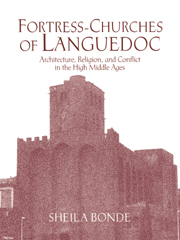Book contents
- Frontmatter
- Contents
- List of illustrations
- Acknowledgments
- Introduction
- 1 Ecclesiastical Fortification in the Middle Ages
- 2 The Larger Context: Languedoc in the Twelfth Century
- 3 The Buildings and the Documents: Maguelone, Agde, and Saint-Pons-de-Thomières
- 4 The Manning and Operation of Fortress-Churches
- 5 The Architectural Context: Sources and Parallels
- Conclusion
- Appendixes
- Tables
- Abbreviations
- Notes
- Bibliography
- Illustration credits
- Index
1 - Ecclesiastical Fortification in the Middle Ages
Published online by Cambridge University Press: 02 November 2009
- Frontmatter
- Contents
- List of illustrations
- Acknowledgments
- Introduction
- 1 Ecclesiastical Fortification in the Middle Ages
- 2 The Larger Context: Languedoc in the Twelfth Century
- 3 The Buildings and the Documents: Maguelone, Agde, and Saint-Pons-de-Thomières
- 4 The Manning and Operation of Fortress-Churches
- 5 The Architectural Context: Sources and Parallels
- Conclusion
- Appendixes
- Tables
- Abbreviations
- Notes
- Bibliography
- Illustration credits
- Index
Summary
I will say of the Lord: He is my refuge and my fortress.
(Psalm 91.1)The link between religious refuge and fortification invoked in Psalm 91 was a potent connection during the medieval period. Many religious establishments, whether they were simple parish churches, cathedrals, monasteries, or even cemeteries, were commonly surrounded by a wall or ditch and were often provided with crenellations, iron-barred doors, fortified gates, and other elements of military defense. Under the Peace of God in the tenth and eleventh centuries (and revived in the twelfth century), churches, cemeteries, and other consecrated sites received formal rights of protection. In what was almost a physical realization of Psalm 91, a place dedicated to God acted as a fortress for those in need of refuge.
The decision to fortify a church was, however, not a matter of simple choice for the clerical patron. Permission needed to be sought and granted by the royal, local, or municipal authority. Beginning in the ninth century, permission to fortify was granted to religious patrons by the Carolingians and by their Capetian successors. Italian and German monasteries were also granted the right to build and to own fortifications from the ninth century. Licenses to crenellate were issued by the English chancery as early as the year 1200. Charles Coulson's study of these licenses demonstrates that monastic and episcopal patrons were every bit as eager for the privilege to fortify their buildings as were their secular counterparts.
- Type
- Chapter
- Information
- Fortress-Churches of LanguedocArchitecture, Religion and Conflict in the High Middle Ages, pp. 11 - 52Publisher: Cambridge University PressPrint publication year: 1994



